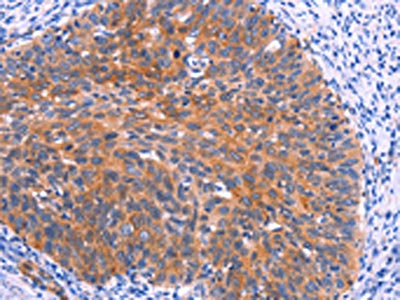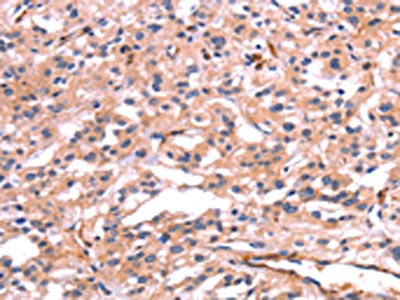
The image on the left is immunohistochemistry of paraffin-embedded Human cervical cancer tissue using CSB-PA930240(PTPN13 Antibody) at dilution 1/30, on the right is treated with synthetic peptide. (Original magnification: x200)
PTPN13 Antibody
CSB-PA930240
ApplicationsELISA, ImmunoHistoChemistry
Product group Antibodies
ReactivityHuman
TargetPTPN13
Overview
- SupplierCusabio
- Product NamePTPN13 Antibody
- Delivery Days Customer20
- ApplicationsELISA, ImmunoHistoChemistry
- CertificationResearch Use Only
- ClonalityPolyclonal
- ConjugateUnconjugated
- Gene ID5783
- Target namePTPN13
- Target descriptionprotein tyrosine phosphatase non-receptor type 13
- Target synonymsFAP-1; fas-associated protein-tyrosine phosphatase 1; hPTP1E; hPTPE1; PNP1; protein tyrosine phosphatase, non-receptor type 13 (APO-1/CD95 (Fas)-associated phosphatase); protein-tyrosine phosphatase 1E; protein-tyrosine phosphatase PTPL1; PTP1E; PTP-BAS; PTP-BL; PTPL1; PTPLE; tyrosine-protein phosphatase non-receptor type 13
- HostRabbit
- IsotypeIgG
- Protein IDQ12923
- Protein NameTyrosine-protein phosphatase non-receptor type 13
- Scientific DescriptionThe protein encoded by this gene is a member of the protein tyrosine phosphatase (PTP) family. PTPs are signaling molecules that regulate a variety of cellular processes including cell growth, differentiation, mitotic cycle, and oncogenic transformation. This PTP is a large intracellular protein. It has a catalytic PTP domain at its C-terminus and two major structural domains: a region with five PDZ domains and a FERM domain that binds to plasma membrane and cytoskeletal elements. This PTP was found to interact with, and dephosphorylate, Fas receptor and IkappaBalpha through the PDZ domains. This suggests it has a role in Fas mediated programmed cell death. This PTP was also shown to interact with GTPase-activating protein, and thus may function as a regulator of Rho signaling pathways. Four alternatively spliced transcript variants, which encode distinct proteins, have been reported.
- ReactivityHuman
- Storage Instruction-20°C or -80°C
- UNSPSC12352203

